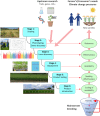The rice Trait Development Pipeline: a systematic framework guiding upstream research for impact in breeding, with examples from root biology
- PMID: 41132321
- PMCID: PMC12540618
- DOI: 10.1007/s11104-025-07399-2
The rice Trait Development Pipeline: a systematic framework guiding upstream research for impact in breeding, with examples from root biology
Abstract
Background: In crop breeding, 'trait development' is the improvement of specific characteristics, typically using landraces as a source for introduction into elite lines. Trait development exists upstream of 'breeding,' which generates new varieties to be grown by farmers. While both are active areas of research, trait development is often overlooked, despite being a critical step in linking upstream research with breeding. The field of root biology provides many excellent examples of upstream research that requires further trait development to generate new varieties.
Scope: Here, we describe the IRRI rice Trait Development Pipeline which provides a framework of clear protocols to discover, test and validate research outputs and maximize their potential for impact in mainstream breeding. We recommend specific steps in the context of further trait development for several rice root biology studies based on the guidelines established in the IRRI rice Trait Development Pipeline. Common trait development recommendations for areas such as root biology include ensuring the relevance of studied traits to field performance, rigorous testing to ensure reliability of genes and marker systems in elite backgrounds, and the packaging of those genes into elite material that can be easily used in breeding.
Conclusion: In implementing the Trait Development Pipeline, it is expected that recurrent selection-based breeding strategies will benefit more from linkages with upstream research areas, such as root biology, by implementing marker-assisted selection to increase the frequency of large-effect rare alleles that currently exist outside the elite gene pool without hindering the genetic improvement that comes from quantitative breeding methods.
Supplementary information: The online version contains supplementary material available at 10.1007/s11104-025-07399-2.
Keywords: Breeding; GWAS; Population; QTL; Rice; Root; Trait development.
© The Author(s) 2025.
Conflict of interest statement
Competing interestsThe authors have no relevant financial or non-financial interests to disclose.
Figures


References
-
- Anila M, Mahadeva Swamy HK, Kale RR et al (2018) Breeding lines of the Indian mega-rice variety, MTU 1010, possessing protein kinase OsPSTOL (Pup1), show better root system architecture and higher yield in soils with low phosphorus. Mol Breeding 38:147. 10.1007/s11032-018-0903-1
-
- Baker M (2016) 1,500 scientists lift the lid on reproducibility. Nature 533:452–454. 10.1038/533452a - PubMed
-
- Bernardo R (2009) Genomewide selection for rapid introgression of exotic germplasm in maize. Crop Sci 49:419–425. 10.2135/cropsci2008.08.0452
Publication types
LinkOut - more resources
Full Text Sources
